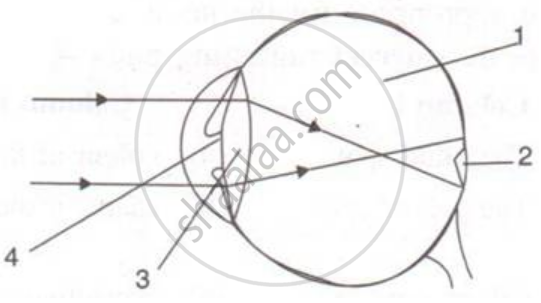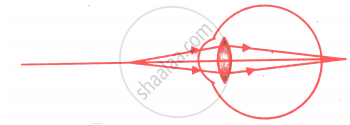Advertisements
Advertisements
Question
What are the two most common defects of vision (or defects of eye)? How are they corrected?
Solution
The two most common defects of vision (or defects of the eye) are the following.
1. Myopia (short-sightedness or near-sightedness): Myopia is an eye defect because of which a person cannot see faraway objects clearly but can see nearby objects normally. By using spectacles with concave lenses, myopia can be corrected, as a concave lens reduces the converging power of the eye lens and therefore forms the images of faraway objects on the retina of the myopic eye.
2. Hypermetropia (long-sightedness or far-sightedness): Hypermetropia is an eye defect because of which a person cannot see nearby objects clearly but can see faraway objects normally. By using spectacles with convex lenses, hypermetropia can be corrected, as a convex lens increases the converging power of the eye lens and therefore forms the images of nearby objects on the retina of the hypermetropic eye.
The two most common defects of vision (or defects of the eye) are the following.
1. Myopia (short-sightedness or near-sightedness): Myopia is an eye defect because of which a person cannot see faraway objects clearly but can see nearby objects normally. By using spectacles with concave lenses, myopia can be corrected, as a concave lens reduces the converging power of the eye lens and therefore forms the images of faraway objects on the retina of the myopic eye.
2. Hypermetropia (long-sightedness or far-sightedness): Hypermetropia is an eye defect because of which a person cannot see nearby objects clearly but can see faraway objects normally. By using spectacles with convex lenses, hypermetropia can be corrected, as a convex lens increases the converging power of the eye lens and therefore forms the images of nearby objects on the retina of the hypermetropic eye.
The two most common defects of vision (or defects of the eye) are the following.
1. Myopia (short-sightedness or near-sightedness): Myopia is an eye defect because of which a person cannot see faraway objects clearly but can see nearby objects normally. By using spectacles with concave lenses, myopia can be corrected, as a concave lens reduces the converging power of the eye lens and therefore forms the images of faraway objects on the retina of the myopic eye.
2. Hypermetropia (long-sightedness or far-sightedness): Hypermetropia is an eye defect because of which a person cannot see nearby objects clearly but can see faraway objects normally. By using spectacles with convex lenses, hypermetropia can be corrected, as a convex lens increases the converging power of the eye lens and therefore forms the images of nearby objects on the retina of the hypermetropic eye.v
APPEARS IN
RELATED QUESTIONS
Do you know that the corneal-impairment can be cured by replacing the defective cornea with the cornea of the donated eye? How and why should we organise groups to motivate the community members to donate their eyes after death?
Name the defect of vision which makes the eye-lens cloudy resulting in blurred vision.
Though a woman can see the distant object clearly, she cannot see the nearby objects clearly. She is suffering from the defect of vision called:
(a) long-sight
(b) short-sight
(c) hind-sight
(d) mid-sight
The picture given here shows a person wearing 'half-moon' spectacles. What sort of eye-defect do do you think he has? Why are these particular spectacles useful to him?
A person can read a book clearly only if he holds it at an arm's length from him. Name the defect of vision:
if the person is a young man
State one role of ciliary muscles in the human eye.
Select the odd one in the following series:
Endolymph, Tympanic membrane, Semi-circular canal, Blind spot.
Given below is a diagram depicting a defect of the human eye? Study the same and answer the question that follow:

Give two possible reasons for this defect of the eye in human beings.
In Myopia the human eye _______.
Given below is a diagram showing a defect of vision. Name the defect of vision and draw an accurately labelled diagram to correct this defect.

